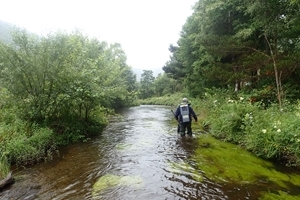 The question of how brown trout (Salmon trutta) can live in waterways polluted by toxic metals is being tackled by PhD student Daniel Osmond in a new collaboration between the Game & Wildlife Conservation Trust Wales and Exeter and Cardiff Universities. Daniel, who is a NERC-funded GW4 FRESH* PhD student, is working with the GWCT Wales team this summer to examine the UK-wide impact of metal pollution and how populations of brown trout are able to persist in rivers with highly toxic metals, such as arsenic and lead.
The question of how brown trout (Salmon trutta) can live in waterways polluted by toxic metals is being tackled by PhD student Daniel Osmond in a new collaboration between the Game & Wildlife Conservation Trust Wales and Exeter and Cardiff Universities. Daniel, who is a NERC-funded GW4 FRESH* PhD student, is working with the GWCT Wales team this summer to examine the UK-wide impact of metal pollution and how populations of brown trout are able to persist in rivers with highly toxic metals, such as arsenic and lead.
Building on work by a former University of Exeter PhD student, Josie Paris, funded by the Environment Agency and the Westcountry Rivers Trust, who focused on trout populations in Cornish rivers, in particular the zinc and copper impacted River Hayle, this project will examine the UK-wide impact of metal pollution on complex regional trout population structures. The project will utilise the very latest genetic tools available, drawing upon the molecular specialisms of Jamie Stevens at the University of Exeter and Mike Bruford at Cardiff University. Daniel will examine adaptations in the fish by comparing whole-genome sequences of trout from metal-polluted and ‘clean’ rivers from different regions. The recent publication of the brown trout genome will allow identification of specific regions within the genome responsible for adaption to metals.
Dylan Roberts, Head of Fisheries for GWCT Wales, said, “Daniel will be joining members of the GWCT Wales fisheries team to start sampling populations of trout from mid- and north Wales, where there has been a long history of metal mining.
“Daniel will question how fish with a different genetic background to those already studied in Cornwall can respond to the same environmental stressors of metal toxicity.”
The study will also allow the team to examine another unanswered question of key interest to fisheries management and conservation: how do cocktails of different metals within rivers affect fish adaption?
Against a backdrop of species decline and extinction, as widely reported within the media, such questions can highlight the value of brown trout not simply as a single unit, but can emphasise the importance of conserving the complex genetic variation present within contemporary populations of a species throughout its range, thereby safeguarding the genetic diversity that can allow species to adapt rapidly to environmental change.
Notes to editors
The Game & Wildlife Conservation Trust – providing research-led conservation for a thriving countryside. The GWCT is an independent wildlife conservation charity which has carried out scientific research into Britain’s game and wildlife since the 1930s. We advise farmers and landowners on improving wildlife habitats. We employ more than 60 post-doctoral scientists and other research staff with expertise in areas such as birds, insects, mammals, farming, fish and statistics. We undertake our own research as well as projects funded by contract and grant-aid from government and private bodies.
For information, contact:
Eleanor Williams
Telephone: 07592 025476
Email: press@gwct.org.uk